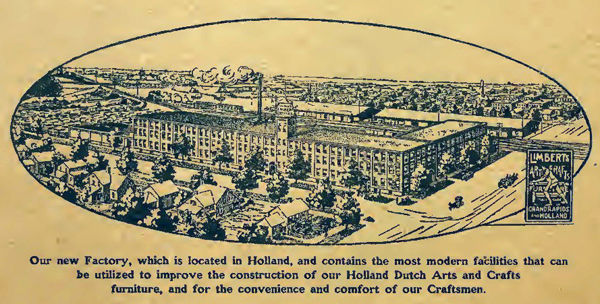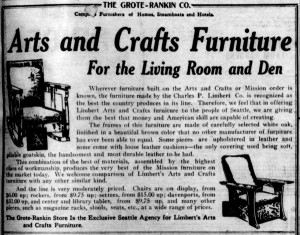After years as a traveling salesman of furniture and a failed manufacturing partnership, Limbert founded the Charles P. Limbert furniture company in 1894 and spent the rest of the decade building it. By the turn of the century, his reputation as a furniture salesman was well established–the April 1901 Furniture Record called him the “furniture commission man.” That skill earned him several prominent contracts, including the Patlind Hotel in Grand Rapids, the Grand Canyon Hotel, the Mission Inn (Riverside, CA), and the Old Faithful Inn in Yellowstone National Park.
The company’s growing success prompted Limbert to build a new factory in Holland, Michigan in 1906. The new factory was three times the size of the original building and featured modern machinery and easy railway access. Even this expanded space would prove inadequate as the company expanded. It doubled in size through a series of additions over the course of just a few years.
All this capacity supported an expanding product line pushed through a national distribution network. Limbert did not sell directly to customers, instead building relationships with a network of merchants across the country. Re-sellers could count on sponsored national campaigns that included streetcar signs and ads in The Craftsman. They would also receive signs customized with their names for display in storefront windows, color portfolios for in-store use and black and white booklets they could send home with interested customers.
Even the best advertising couldn’t prevent changing taste. As interest in Arts and Crafts furniture faded, Limbert shifted production to meet those tastes and successfully weathered the storms that would sink Stickley. Though later catalogs still featured some of Limbert’s most distinctive Arts and Crafts pieces, they shared the page with a variety of styles, including Chinese, Italian, Queen Anne, and William and Mary.
In 1921 Limbert suffered a stroke while traveling in Hawaii. He would never recover fully, and declining health prompted him to sell his shares in the company in September of 1922. He was dead less than a year later. The company that bore his name survived Limbert’s death, but it could not survive the economic austerity imposed by World War II. It closed in 1944.


